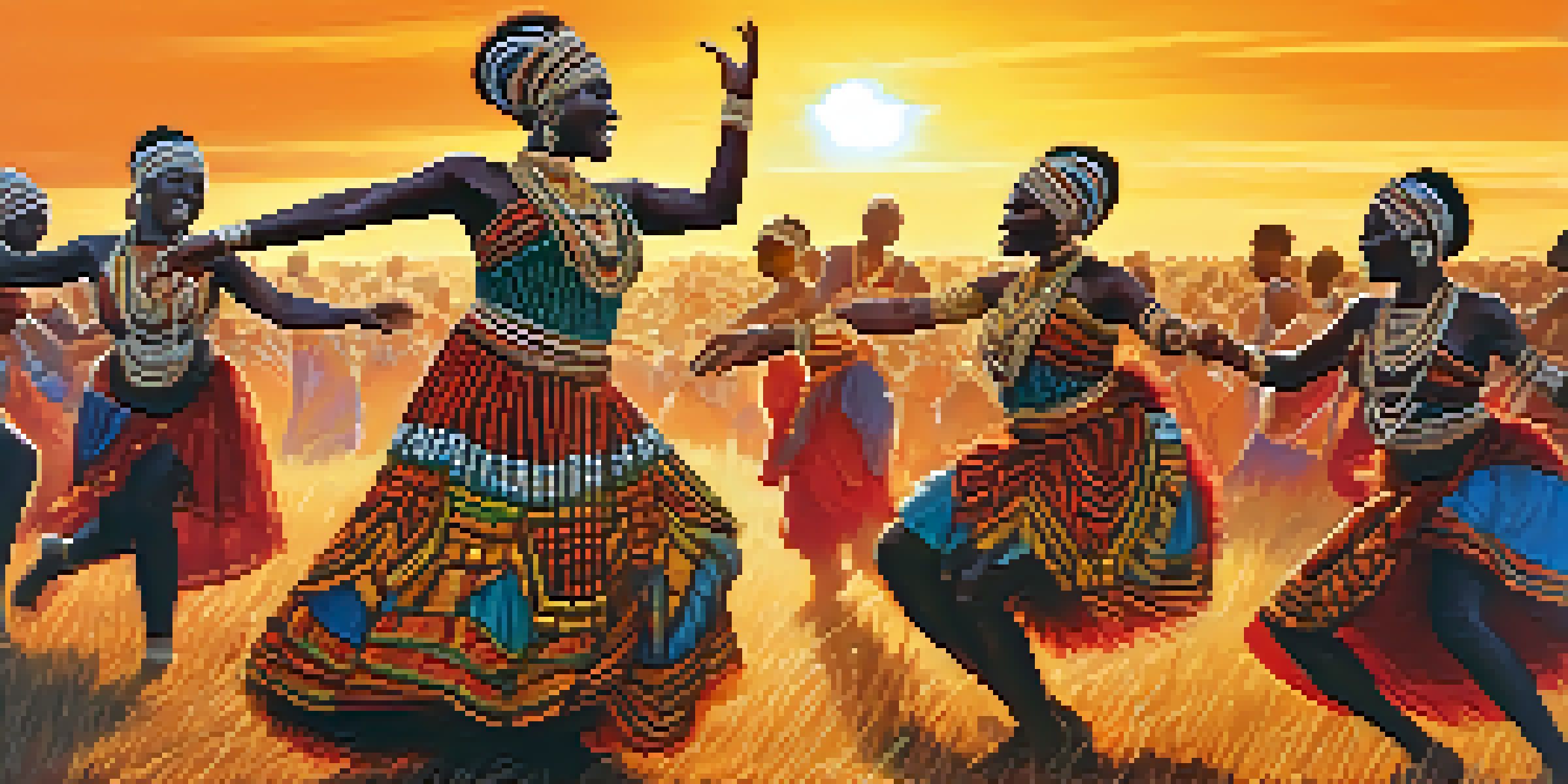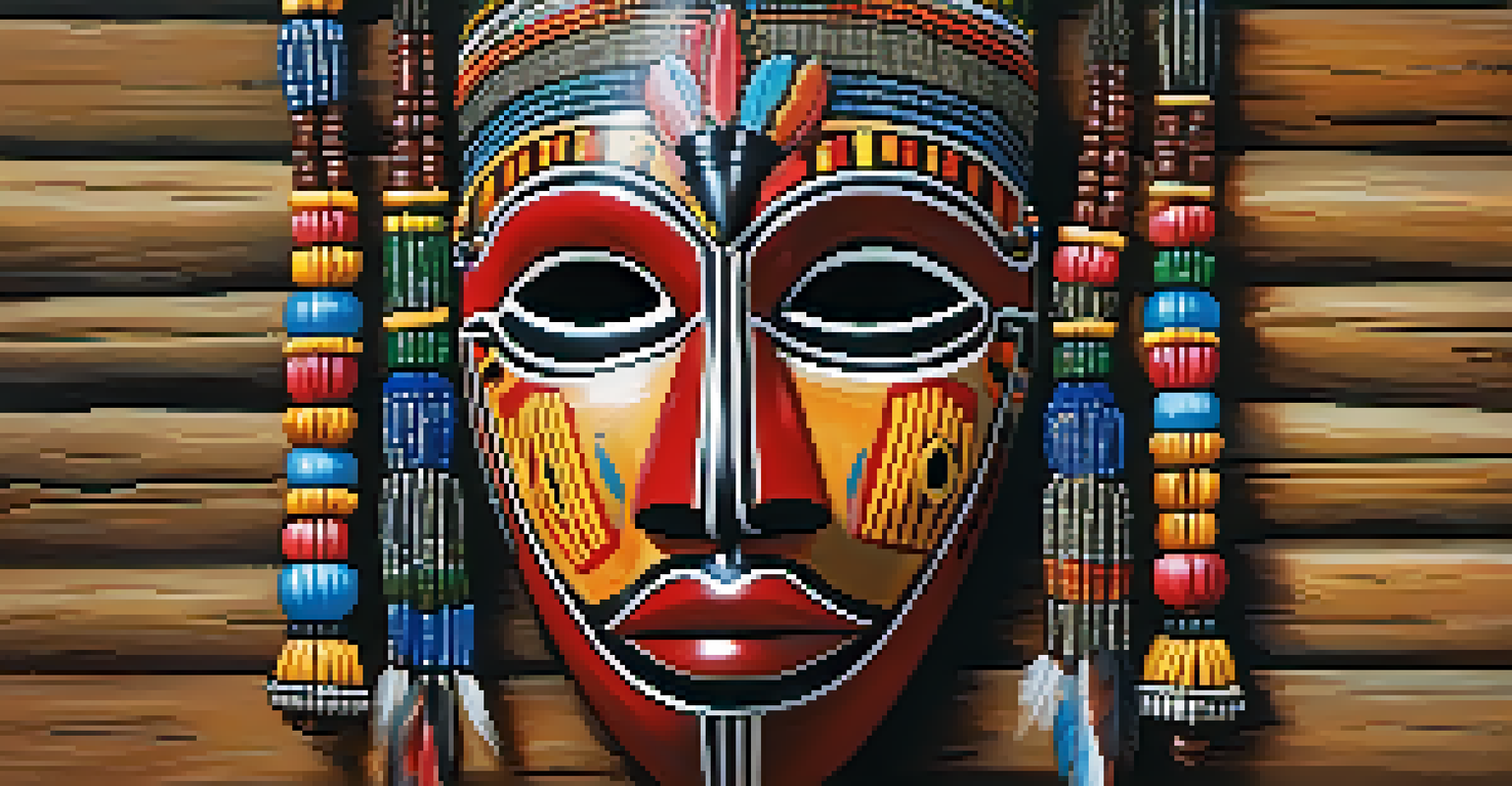Understanding the Rhythms of African Traditional Dances

The Significance of Dance in African Cultures
Dance in African cultures is more than just movement; it serves as a vital form of expression and communication. From celebrations to rituals, each dance tells a story steeped in tradition, often reflecting the community's values and history. For instance, dances performed during harvest celebrations honor the earth and the ancestors, fostering a deep connection to their roots.
Dance is the hidden language of the soul.
In many African societies, dance is a communal activity that strengthens bonds among participants. It invites everyone, young and old, to join in, reinforcing the idea that dance is a shared experience rather than a solo performance. This communal aspect is crucial, as it cultivates unity and collective identity, essential elements in many African cultures.
Moreover, dance can act as a bridge between generations, passing down stories and wisdom through movement. Elders often teach the youth the steps and meanings of traditional dances, ensuring that cultural heritage is preserved. This intergenerational exchange enriches the community's identity, keeping traditions alive.
Understanding the Rhythmic Patterns in Dance
Rhythm is the heartbeat of African traditional dances, guiding the movements and bringing life to the performance. Each dance has its unique rhythm, often dictated by the accompanying music, which can include drums, claps, and vocalizations. For example, the djembe drum, common in West African music, creates intricate patterns that dictate the tempo and style of the dance.

The interplay between dancer and musician is crucial, as dancers often respond intuitively to the music’s rhythm. This dynamic creates a dialogue between the dancer's movements and the sounds produced, making every performance a unique experience. It’s as if the dancer becomes a part of the music, embodying its essence through their body.
Dance as Cultural Expression
African dance serves as a vital form of expression, telling stories that reflect the community's values and history.
Additionally, many African dances incorporate polyrhythms, where multiple rhythms are played simultaneously. This complexity not only challenges the dancer but also creates a rich auditory experience for the audience. The beauty of these rhythms lies in their ability to evoke emotions, making each dance a profound expression of cultural identity.
The Role of Costumes and Symbols in Dance
Costumes in African traditional dances are not merely decorative; they carry deep symbolic meanings and enhance the storytelling aspect of the performance. Often made from vibrant fabrics and adorned with beads, feathers, or masks, these costumes reflect the dancer's cultural background and the specific dance being performed. For instance, masks may represent ancestral spirits or deities, adding a spiritual dimension to the dance.
The dance is a poem of which each movement is a word.
Each element of the costume is carefully chosen, with colors and designs conveying specific messages or themes. For example, red might symbolize strength and bravery, while white could represent purity and peace. This intentional use of color and symbolism helps convey the narrative of the dance, making it more impactful for the audience.
Moreover, the act of wearing these costumes fosters a sense of pride and belonging among dancers. It connects them to their heritage and emphasizes the importance of cultural identity in the performance. This connection is palpable, as dancers often feel empowered when donning traditional attire, allowing them to fully embody the spirit of their ancestors.
Different Types of Traditional African Dances
African traditional dances are incredibly diverse, with each region and community having its distinct styles and forms. For example, the Adumu dance of the Maasai people is characterized by jumping and is performed during ceremonies to showcase strength and agility. In contrast, the Umteyo dance from the Xhosa people emphasizes flowing movements, often telling a story of love or struggle.
These varied dance forms serve different purposes, from celebrating milestones like weddings to mourning the loss of loved ones. Each dance is infused with cultural significance, often tied to specific rituals or events within the community. This variety showcases the rich tapestry of African cultures, each contributing to the broader narrative of the continent's heritage.
Rhythms Connect People
The intricate rhythms of African dances foster a unique dialogue between dancers and musicians, enhancing the overall performance.
Additionally, many dances are influenced by historical events, migrations, and interactions with other cultures. As communities evolve, so do their dances, adapting to contemporary issues while retaining their traditional roots. This fluidity ensures that traditional dances remain relevant, resonating with both the performers and their audiences.
Learning Traditional Dances: A Journey of Discovery
Learning traditional African dances offers a unique opportunity to connect with cultural heritage in a tangible way. Many communities offer workshops and classes where individuals can immerse themselves in the rhythms, movements, and stories behind the dances. This hands-on experience fosters appreciation and respect for the culture, making it a journey of discovery for participants.
As students learn the steps, they also uncover the historical and social contexts of the dances. This knowledge deepens their understanding and encourages a greater appreciation for the cultural significance of the movements. For instance, learning the Agbekor dance of the Ewe people reveals its roots in ancient warrior practices, enriching the experience.
Moreover, participating in traditional dance can create a sense of belonging and community, regardless of one's background. Many dancers find joy in the shared experience of learning and performing together, breaking down barriers and fostering connections. This cultural exchange highlights the universal language of dance, which can unite people from diverse backgrounds.
The Influence of African Dances on Global Dance Styles
The rhythms and movements of African traditional dances have significantly influenced global dance styles, enriching the world of performing arts. Genres like jazz, hip-hop, and contemporary dance frequently draw inspiration from African rhythms and techniques. For example, the syncopated rhythms found in African drumming can be heard in modern music, creating a fusion that transcends cultural boundaries.
Moreover, many dance companies around the world incorporate African dance techniques into their performances, showcasing the beauty and complexity of these movements. This integration not only celebrates African heritage but also educates audiences about the cultural significance behind the dances. Such representations help to preserve traditional forms while making them accessible to a wider audience.
Preservation of Heritage
Efforts to teach and document traditional dances are crucial for maintaining cultural heritage and identity for future generations.
Additionally, the global popularity of African dance styles has sparked interest in traditional forms, encouraging a resurgence of cultural pride within African communities. As more people seek to learn and share these dance styles, the rich heritage of African dance continues to thrive, bridging cultures and fostering understanding among diverse populations.
Preserving African Traditional Dances for Future Generations
Preserving African traditional dances is essential for maintaining cultural heritage and identity in a rapidly changing world. As globalization increases, many communities face the challenge of keeping their traditions alive amidst external influences. Efforts to document and teach these dances play a crucial role in ensuring that future generations can connect with their cultural roots.
Community initiatives, workshops, and cultural festivals are vital in promoting awareness and interest in traditional dances. By actively engaging younger generations, these programs help foster a sense of pride and belonging. Through participation, young people not only learn the dances but also appreciate the stories and values they embody.

Furthermore, technology plays a role in preservation, with digital platforms allowing for the sharing of traditional dances worldwide. Online tutorials, social media, and virtual performances provide opportunities for learning and appreciation beyond geographical boundaries. This blending of tradition and modernity ensures that African dances will continue to resonate and evolve for generations to come.